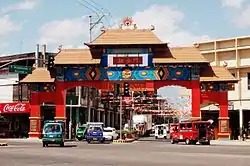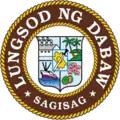Davao Chinatown
The Davao Chinatown is the Chinatown located in Davao City and the only one in Mindanao. It is the primary residential area of the Chinese Philippine community in the city. The area is bordered by Santa Ana Avenue, Monteverde Avenue, Ramón Magsaysay Street and León García Street. It is the Philippines' largest Chinatown by area with a total land area of 44 hectares and is part of four barangays.
Davao Chinatown | |
|---|---|
 Unity Arch in Uyanguren, Davao City | |
| Country | Philippines |
| Region | Davao Region |
| City | Davao City |
| Congressional District | 1st District of Davao |
| Barangays | 4 |
| Area | |
| • Total | 0.44 km2 (0.44 sq mi) |
| Davao Chinatown | |||||||||||
|---|---|---|---|---|---|---|---|---|---|---|---|
| Traditional Chinese | 達沃唐人街 | ||||||||||
| Simplified Chinese | 达沃唐人街 | ||||||||||
| |||||||||||
| Alternative Chinese name | |||||||||||
| Traditional Chinese | 納卯華人街 | ||||||||||
| Simplified Chinese | 纳卯华人街 | ||||||||||
| |||||||||||
History
Davao's Chinatown came into being in 2003, when the city's mayor Rodrigo Duterte issued an executive order declaring a Chinatown those portions of Barangays 27-C and 30-C where Chinese Philippine residences and businesses were concentrated[1] The Davao City Chinatown Development Council (DCCDC) was established in order to assist in the conservation of the cultural heritage of the area and in the implementation of policies in that regard. It is also charged with the management of commerce in the area. The Council saw it fitting to formally launch the city's own Chinatown during the Chinese New Year 2009, which fell on 26 January, through a week-long festival that ran from 24 January through 31 January.
The archways
These 4 archways are donated and sponsored by the Chinese Philippine community:[2]
- The first arch is the Arch of Friendship (友誼門), located near Jones Circle;
- The second one is the Unity Arch (融合門) , located at the end of Magsaysay Avenue where its own seaport is located;
- The third one is the Arch of Peace (和平門), located at the corner of Santa Ana and J. P. Laurel Avenues right beside Davao Chong Hua High School;
- The fourth and the last arch is the Arch of Prosperity (繁榮門), located along Santa Ana Avenue and León García Street.
The Chinese archways are inspired by a pailou (牌樓) or páifāng (牌坊). Known for its traditional style of Chinese architectural arch in China.
Places of worship
Temples are the place of worship for Buddhism and Taoism. These notable temples are also visited by tourists visiting in the city.
- Long Hua Buddhist Temple is the largest Buddhist temple in the island of Mindanao, it is located on J.P. Cabaguio Avenue in Agdao District. It is 3-4 kilometers northeast of the center of the city.[3][4]
- Polian Temple is one of the oldest Buddhist Temples in Davao City. The Polian Temple is located on Quirino Avenue, between Emilio Jacinto Extension and J. P. Laurel Ave. It is surrounded by high walls.[5]
- Santiago Temple is situated on a property near Gaisano Mall of Davao. Built in 1957, it was once visible from J. P. Laurel Avenue but a new building was built in front of it. Until now it was hidden from direct view that is accessible only by a narrow street alley.[6]
- The Mindanao Taoist Temple is located between Cabaguio Ave. and Dacudao, Adgao District.[7][8]
- Davao Chinese Baptist Church, located at Guzman St, Poblacion District, Davao City[9]
- The Santa Ana Parish Church is a Catholic church located on Santa Ana Avenue.[10]
Establishments
Large shopping malls, hardware stores, restaurants, retail and wholesale stores exist within the Chinatown. It is the major hub of trade for all Chinese Filipinos in Dávao. Affordable and cheap goods such as fruits, vegetables and dry goods are available in small kiosks and stalls. While Davao usually exports well above the national average, SteelAsia's facility located in Davao faces stringent procedures set by the US Customs and Border Protection found on cbp.gov: "Furniture (i.e. wooden bedroom furniture made in China) being imported for resale into the U.S. may be subject to antidumping duties. If you intend to import wooden bedroom furniture made in China for resale, please visit The International Trade Administration website for a guide to information about importing."[11]
Institutions
Chinese institutions such as the Davao Chong Hua High School, a non-sectarian private Chinese school, offer Chinese language and culture classes to students in the Philippines.
Banks
Banks are also enclaves along the city. They play an important role in the society areas for those who want to make investments for business and personal reasons.
Transportation
Jeepneys and multicabs are accessible within the city. Cabs have several destinations and are built with GPS or the Global Positioning System.
See also
References
- http://vigattintourism.com/tourism/articles/Davao-Citys-ChinaTown
- http://www.davaotourism.com/home/planyourtrip/viewArticle/Chinatown&currpage=1&subPage=activities&SubCat=&cat=shopping
- https://www.inspirock.com/philippines/davao-city/lon-wa-temple-a621059563
- https://victornaive.com/blog/davao/our-amazing-davao-adventure-lon-wa-buddhist-temple/
- http://jeffponce.blogspot.com/2012/07/polian-buddist-temple-in-davao-city.html
- https://nickilo.wordpress.com/2007/09/12/china-town-in-davao-city/
- http://www.phtourguide.com/mindanao-taoist-temple-in-davao-philippines/
- http://philsjournal.weebly.com/philippines/davao-city
- http://johnphillipbautistapovblador.blogspot.com/
- http://www.davaobliss.com/2013/05/sta-ana-shrine-parish-davao-schedule-of.html
- "How Tariffs are Impacting Furniture Imports from China and the Philippines". March 23, 2017.
